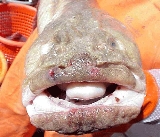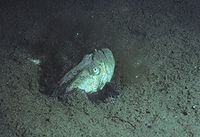
Wrymouth
Encyclopedia
The wrymouth, Cryptacanthodes maculatus, sometimes called ghostfish, is a slim, eel
-like creature belongs to the wrymouth family
Cryptacanthodidae
. It outgrows the blennies, its relatives, and may reach 3 ft (or even over 5 feet http://www.adn.com/news/alaska/wildlife/marine/story/941716.html). A low spiny dorsal fin
stands along the entire back. This includes about 70 spines and unites with the caudal and anal fins. Small eyes lie near the top of its big head. The mouth slants sharply above a ponderous lower jaw. Along its reddish brown upper sides extend several irregular rows of small dark spots. The dorsal and anal fins also show spots. The lack of ventral fins and a pronounced upward pointing mouth are characteristic.
, it ordinarily hugs the bottom from shallow water down to considerable depths. It creates burrows in the mud bottom on which it lives. About 2 inch
es around and 1.5 to 3 in below the surface, the burrow branches into tunnels. Sometimes, however, the burrow stands as high as 4 feet above the low water mark. It begins in a centrally placed mound with smaller openings along the tunnel and at its end. Usually it eats small invertebrates such as shrimp
and crabs. At night, they may be seen protruding about a head's length from their burrows, but are seldom seen out in the open. In thousands of hours of night diving in their habitat, we only observed one out of its burrow once, and when disturbed it returned immediately to the nearest opening. It spawns in the winter, probably in deep water. Little is known about their food, but it seems likely that they feed mainly on amphipods and mud shrimp
and perhaps the occasional small fish.

tube as a ready-made burrow. ]
Eel
Eels are an order of fish, which consists of four suborders, 20 families, 111 genera and approximately 800 species. Most eels are predators...
-like creature belongs to the wrymouth family
Family (biology)
In biological classification, family is* a taxonomic rank. Other well-known ranks are life, domain, kingdom, phylum, class, order, genus, and species, with family fitting between order and genus. As for the other well-known ranks, there is the option of an immediately lower rank, indicated by the...
Cryptacanthodidae
Cryptacanthodidae
Cryptacanthodidae is a family of fish containing a single genus, Cryptacanthodes. There are four species in the genus Cryptacanthodes. This family is also known by the common names risueños, terrassiers and wrymouths.-External links:*...
. It outgrows the blennies, its relatives, and may reach 3 ft (or even over 5 feet http://www.adn.com/news/alaska/wildlife/marine/story/941716.html). A low spiny dorsal fin
Dorsal fin
A dorsal fin is a fin located on the backs of various unrelated marine and freshwater vertebrates, including most fishes, marine mammals , and the ichthyosaurs...
stands along the entire back. This includes about 70 spines and unites with the caudal and anal fins. Small eyes lie near the top of its big head. The mouth slants sharply above a ponderous lower jaw. Along its reddish brown upper sides extend several irregular rows of small dark spots. The dorsal and anal fins also show spots. The lack of ventral fins and a pronounced upward pointing mouth are characteristic.
Distribution and habitat
Dwelling along the North Atlantic coast of North AmericaNorth America
North America is a continent wholly within the Northern Hemisphere and almost wholly within the Western Hemisphere. It is also considered a northern subcontinent of the Americas...
, it ordinarily hugs the bottom from shallow water down to considerable depths. It creates burrows in the mud bottom on which it lives. About 2 inch
Inch
An inch is the name of a unit of length in a number of different systems, including Imperial units, and United States customary units. There are 36 inches in a yard and 12 inches in a foot...
es around and 1.5 to 3 in below the surface, the burrow branches into tunnels. Sometimes, however, the burrow stands as high as 4 feet above the low water mark. It begins in a centrally placed mound with smaller openings along the tunnel and at its end. Usually it eats small invertebrates such as shrimp
Shrimp
Shrimp are swimming, decapod crustaceans classified in the infraorder Caridea, found widely around the world in both fresh and salt water. Adult shrimp are filter feeding benthic animals living close to the bottom. They can live in schools and can swim rapidly backwards. Shrimp are an important...
and crabs. At night, they may be seen protruding about a head's length from their burrows, but are seldom seen out in the open. In thousands of hours of night diving in their habitat, we only observed one out of its burrow once, and when disturbed it returned immediately to the nearest opening. It spawns in the winter, probably in deep water. Little is known about their food, but it seems likely that they feed mainly on amphipods and mud shrimp
Mud shrimp
The term mud shrimp is used for a number of different mud-dwelling crustaceans:*Infraorder Thalassinidea, including genera such as Callianassa, Pestarella and Upogebia*Corophium volutator, an amphipod of the North Atlantic...
and perhaps the occasional small fish.

Reproduction
Almost nothing is known about their reproductive biology. Small, but well developed fry have been recorded from the northern parts of their range in early spring, suggesting that spawning may take place in winter. Eggs and early fry are completely unknown, suggesting the possibility that spawning may take place inside the burrow system. Nothing is known about territoriality, mating strategies, or whether they provide parental care.In the aquarium
In aquaria the wrymouth has been known to utilize a rubberRubber
Natural rubber, also called India rubber or caoutchouc, is an elastomer that was originally derived from latex, a milky colloid produced by some plants. The plants would be ‘tapped’, that is, an incision made into the bark of the tree and the sticky, milk colored latex sap collected and refined...
tube as a ready-made burrow. ]

